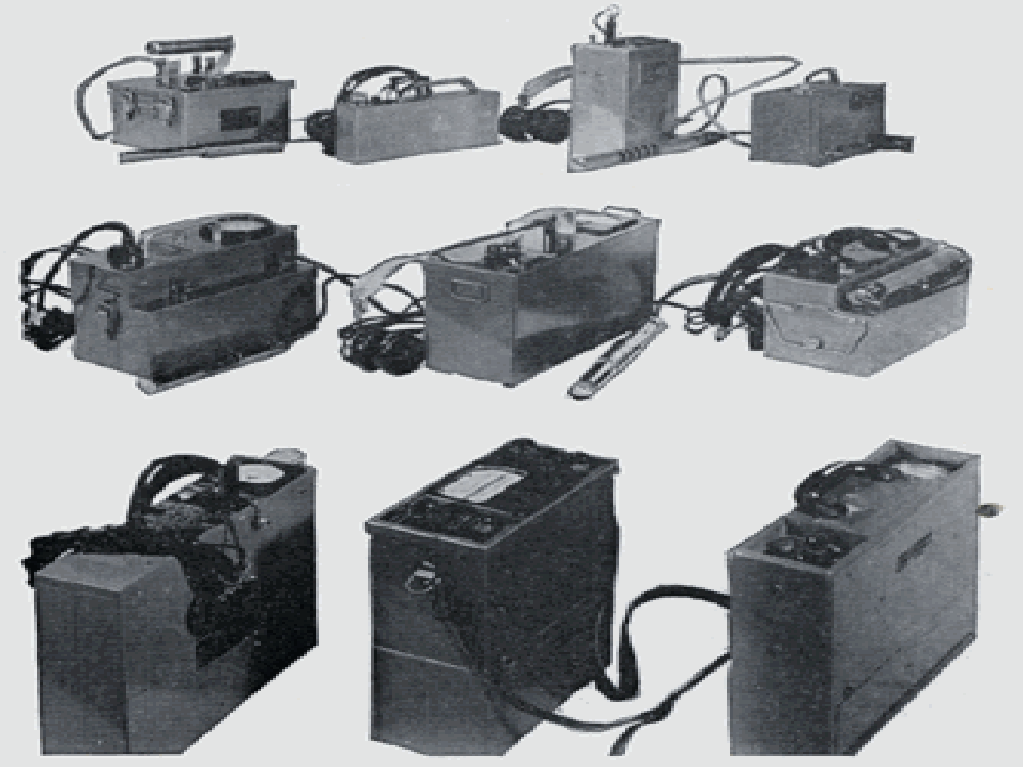
US Atomic Energy Commission
In 1945, there were only five commercial companies making radiation detector systems. As a result, the government established instrument development centers in Chicago, Oak Ridge and Los Alamos to build radiation detection equipment to support the Manhattan Project. As the war ended, experienced equipment develops from the national laboratories began starting their own companies to produce the equipment. The companies started out modestly but with high technical competence. From 1946-1948, the market was primarily for the military, AEC or universities. The use of radioisotopes in industry and the medical field was increasing. The Navy primarily went with the larger companies, whereas the AEC dealt with the small companies. The number of companies increased from 44 in 1948 to 73 in 1954. Sales increased during the same period from four to thirty million dollars annually.
With the announcement of the domestic uranium program in 1948, the industry was ready with portable radiation instruments. The government also was liberal in releasing technical information on radiation detectors and provided liberal use of the patents. This allowed companies to develop instruments as little cost. The uranium prospecting era was a key driver in simplifying electronics, increasing reliability and decreasing the overall weight. Since the majority of the weigh was in the batteries, considerable attention was paid on reducing the battery weight and bulk size. Being able to repair the instrument in the field became more important, so simple replacement procedures and parts were implemented. If the unit had to be returned to the factory, it needed to be repaired quickly and returned to the prospector.
As the prospecting era continued, the scintillation counter came on the portable instrument market. It provided considerably more sensitivity than the geiger counter. The scintillators were considerably faster and have a higher efficiency. The scintillator is typically 50 times more sensitive than the geiger counter.
With the sales of detection equipment increasing, several stores opened which sold a variety of detection equipment from several manufacturers. Before this, all sales were conducted with the factory. With little technical expertise, these store housed concentrated on equipment that was reliable, simple to use and had low cost batteries.
Also at this time, manufacturers began offering a wider range of model from the low cost to expensive to provide a product for every level of prospector. The more expensive the unit, the better sensitivity and more “bells and whistles”. As the sales of particular price ranges increases, the costs began to come down.
One exception was Victoreen, which was start in 1931, and was the only commercial maker of radiation instruments prior to 1946. Victoreen primarily produced radiation measuring equipment for the medical xray field such as condenser meters or r-meters. Herbach and Rademan began making instruments in early 1940’s designed to measure x-ray dosage. Prior to the 1940’s, there were very few radioactive materials in use mainly radium and radon. The x-ray requirements for measurements were relatively low dosage. Occasionally some radium would be misplaced and a geiger counter would be called into service to locate the valuable materials.
Prior to the atomic piles, radium and x-rays were the perceived problems from radiation.
The first atomic pile began operation on December 2, 1942 at the University of Chicago. It was at the Metallurgical Laboratory that the term Health Physics was coined. Health physics faces many challenges which included designing and testing new measuring instruments, shielding development, determining absorption and scattering, determining tolerance levels, and supporting separation processes.
The Oak Ridge pile began operating on November 2, 1943. It turned out that the scientist and engineers were so interested in their work that they often overlook the radiation hazard.
Uranium, which is used in the piles, was not very radioactive. However, when irradiated it produced fission products and plutonium, which caused a more series radiation hazard. It was also noted that a worker walking by and an experimental hole in the pile would not suffer an immediate reaction, but could receive a high dose which would show up a few days later.
Later cyclotron research resulted in some nucleonics instrumentation produced by Technical Associates and Cyclotron Specialties. In 1954, there were still two AEC sites producing radiation detection equipment.
The US Atomic Energy Commission developed the first radiation detectors at its laboratories for the Manhattan Engineer District (Manhattan Project) in the early 1940’s. Detectors were developed at the Clinton Engineering Works (later the Oak Ridge National Laboratory), the Metallurgical Laboratory (METLAB) at the University of Chicago, the Hanford Laboratory in Washington, and the Los Alamos Scientific Laboratory (now Los Alamos National Laboratory). In 1947, the Radiation Instruments Branch (initially called the Washington Division of Production), located in Oak Ridge, TN, began cataloging radiation detectors being used at AEC facilities. The catalog attempted to standardize the names of the instruments as opposed to the wartime code names such as Zeus, Cutie Pie, Zeuto and Chang and Eng. The first catalogs were only for government use but in 1949, they were redirected to catalog the emerging commercial radiation instruments and supporting equipment.
Early instruments were developed at the Clinton Laboratories and the University of Chicago. Many of the details of these instruments remained classified until the late 1940’s. In 1947, it was reported by K.M. Morgan that over 30 types of instruments were used by the radiation surveyor group.
In 1945, the AEC cataloged the available radiation instruments throughout the Manhattan Project complex by Mark and Model number. Mark 1 was the designator for Survey Instruments - Area. Mark 2 was the designator for Survey Instruments - Probes.
AEC and USGS Prospecting Booklets
The AEC published several small pocket booklets on uranium prospecting. The two most useful are the Prospecting for Uranium 1949 and Prospecting with a Counter 1954. Both were jointly published by the AEC and USGS. In 1949, the booklet listed 20 manufactures of geiger counters for prospecting and the 1954 booklet listed 40.

AEC Prospecting Guide –1949